Back to conch shells again! This time, as a musical instrument. I admit I do not like to eat conch in any form, but I love the shell. I will not take a conch with a slimey living creature in it, but Al will dive for discarded conch shells on the sea bed to satisfy my little obsession. We now have 19 on board (6 under our bed, 10 drying near the mast, 2 beautiful older ones, and 1 that is now a conch trumpet/horn).
Beth and Lynn invited us for happy hour on Coyote, their beautiful Sailmaster 50. Beth is also quite the conch horn trumpeter. I took a video of her – she is awesome!
Conch horn trivia —
- Conch horns have been used for centuries by indigenous Carribean and Pacific Island natives such as the Arawak Indians but the use of conch.
- The greek god Triton was said to control the ocean’s waves by blowing his conch-shell trumpet.
- Conch horns are also listed by the US Coast Guard as an approved sound making device under the requirements of Rule 33.b and Annex III. (Really??? I had no idea!)
- Sounding a conch shell horn at sunset is a long standing tradition in the Keys and the surrounding Caribbean islands. Here in the Bahamas, at sunset, you can often hear someone, usually a cruiser, blowing a shell trumpet at sunset, sometimes as soon as the sun just touches the water on the horizon, and other times it is a bit later when the last portion of the sun descends out of sight below the horizon. Regardless of exactly when, the sound of the conch horn fills the air and you know you are in the islands.
Al is a very talented man, as evidenced by our beautiful sailboat. Making a conch horn should be an easy task for this master craftsman. I selected one of my shells for this new role. Criteria – a very clean one, and one whose interior coral color has faded.
After dremeling, there was no hole. Switched to a new end on the dremel and drilled that hole.
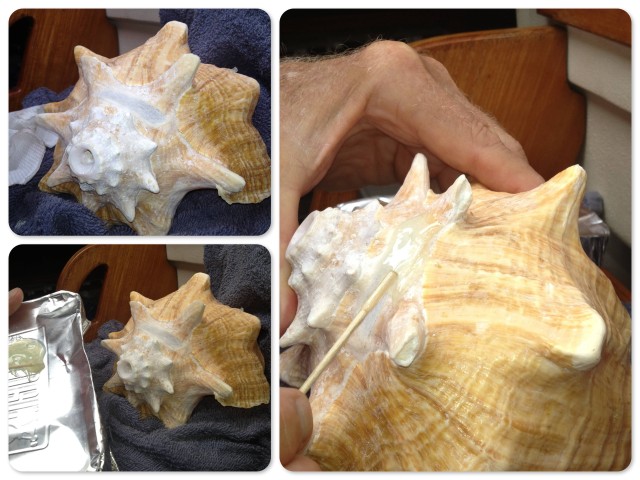
Tonight a large group of cruisers gathered on the pool deck at the Hope Town Inn and Marina, both dock folks and mooring people for a BIG happy hour. It was a great idea since we could never all fit on one boat! We met even more wonderful people – how can there be so many terrific folks all in one little place?
Jim (on Jumandi, with Gloria) is a conch horn fanatic. He is building a set of shell trumpets in order to acquire as many tones as possible. A conch band, perhaps?
There are a lot of people who can really make those conch horns sound off! Alas, I just cannot get the hang of it. Al is learning and has come close to making that nice deep round tone, but not me. Not yet.
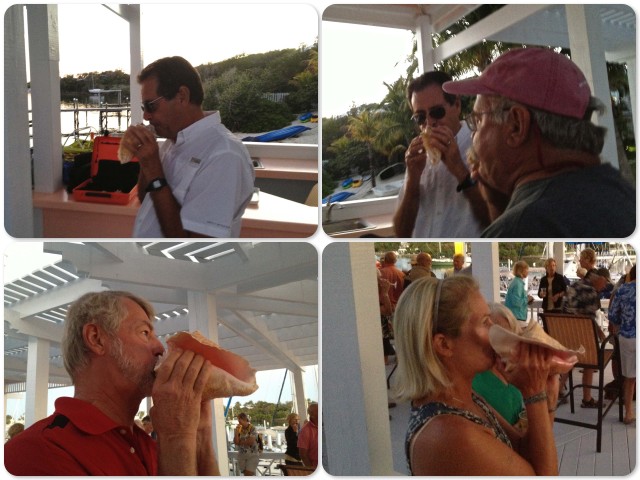
Upper right – a duet by Jim and Will
Lower left – Al
Lower right – me (Good thing there is no audio to these pics.)
I’ll keep trying…… and practicing……. but I’m not sure my talents extend to learning to trumpet at this age. Darn!
If you are as intrigued by conch shells as much as I am, you can read further…….
from “communityconch.org”
- A young conch is often referred to as a “roller” because they have not yet developed the flaring lip of the adults. Without the large adult “lip” on the shell, these juvenile conchs will roll in the surf, hence the name “roller.”
- The queen conch is a large edible sea snail native to the coasts of the Caribbean, the Florida Keys, the Bahamas, and Bermuda. Conchs are herbivores – they eat algae and other tiny marine plants
- Main predators include nurse sharks, loggerhead turtles, other snail species, blue crabs, eagle rays, spiny lobsters, and other crustaceans
- Female conchs lay hundreds of thousands of tiny eggs in a sandy egg mass. The larvae emerge after 5 days and may drift on ocean currents for a month before settling in suitable habitat on the sea floor
- In their first year conchs live under the sand during the day & come out to feed on the surface at night
- A queen conch may take 5 years to reach maturity and can reproduce
- They live an average of 7 years, but are known to live as long as 20 – 30 years
- Conchs produce natural pearls that come in a range of hues, including white, brown, orange & pink
And, if you are also interested in the threatened state of conch, this is a link to a good article, “Conservationists Gear Up to Save Conch in Bahamas” by Larry Smith
A non-profit research group, Community Conch, led by scientist, Martha Davis, has been researching conch. “Our mission is to effect the sustainable harvest of queen conch through research, education and collaboration with local communities, the government and other organisations,” Davis said. “Conch has been a primary food staple for Bahamians, but has recently become threatened by over-exploitation.”
Volunteers count adult and juvenile conchs, mating pairs and egg casings in specified areas – either towed behind boats in shallow water or scuba diving in deep water. They also measure shell lip thickness, which determines age and sexual maturity.
Fifty is the minimum density of adult conch per hectare required for successful mating. (The hectare is a metric unit of area defined as 10,000 square meters, 100 m by 100 m). Community Conch has confirmed that in every commercial fishing ground surveyed over the past five years has less than 10 conchs per hectare, a density which cannot sustain reproduction. The recommended density is 100 conch per hectare for sustainability.

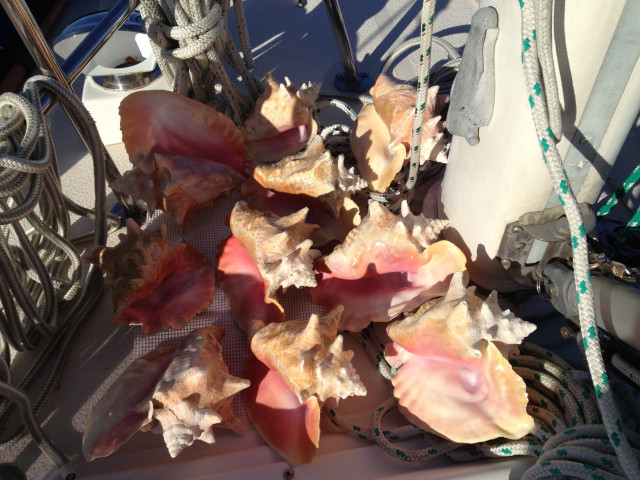
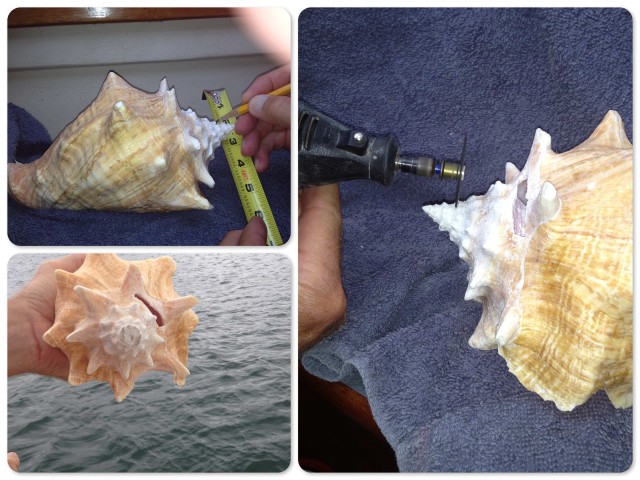
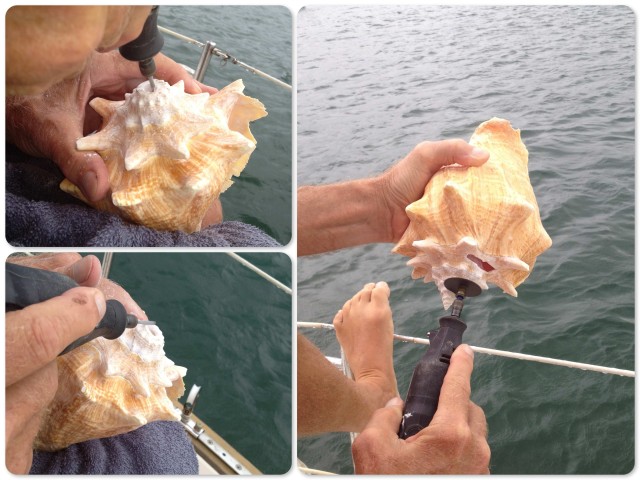
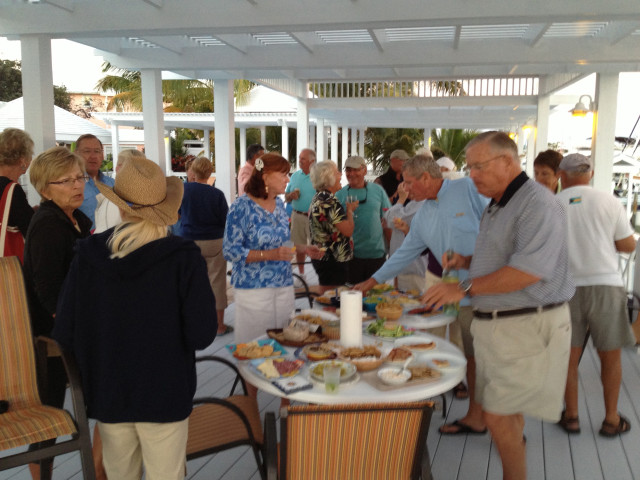

Reader Girl
If you’re still checking responses on this post, India has a long and ancient tradition of blowing conch shells. Look it up! 🙂
watsons
Thanks for that information. I guess many peoples and cultures discovered the sound of the conch. That’s pretty cool to know it is across cultures and oceans.
Brent Adamson
Where are you now?
watsons
We haven’t cruised south since 2016. Too many grandchildren now. We cruise most of the summer in New England.
Got Conch? – Kindred Spirit
[…] the ones we collected (Beach and Sea Treasures), the conch horns Al made (Sounding the Conch Horn 1 & 2), and the various ways people decorate with conch […]
Colleen Murphy
Keep trying! You will get there!